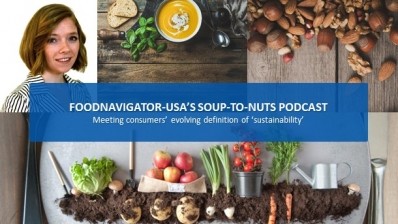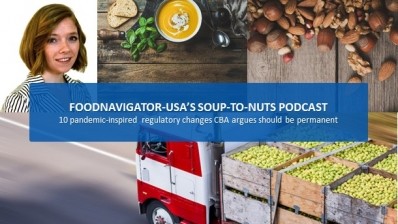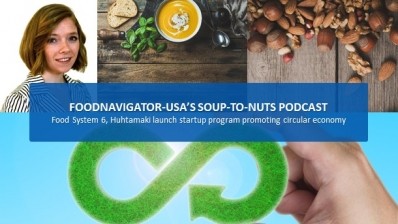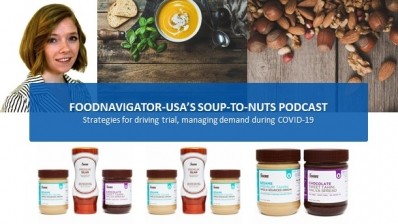Soup-To-Nuts Podcast: How is the coronavirus pandemic & unemployment reshaping snacking?
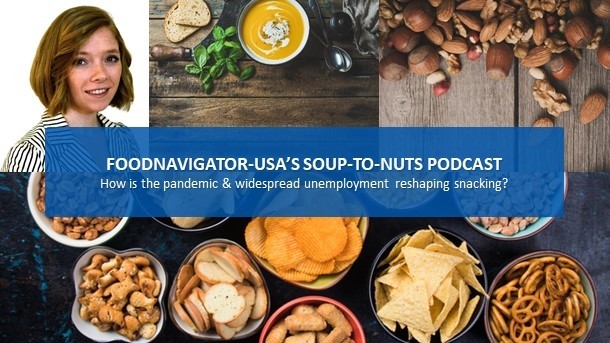
Sure, the idea of eating our feelings is nothing new thanks to mainstream media and marketers for years relying on hackneyed images of women eating pints of ice cream after being dumped or men devouring giant portions of meat to prove their masculinity. But for many, the pandemic and associated stay-at-home orders brought to life these clichés in a way that previously might have seemed cartoonish.
According to Flavorchem market analyst Rebecca Shurhay, consumers’ snacking habits during the pandemic ranged widely from a fierce focus on functional foods that could help shield against the risk of contracting COVID-19 to seeking comfort through anxiety baking, indulgent treats or nostalgic childhood flavors that remind them of a life before the pandemic.
In this episode of FoodNavigator-USA’s Soup-To-Nuts podcast, Shurhay shares how quarantine snacking is shifting, the resulting market opportunities and competitive threats and how consumer shopping and eating habits will continue to evolve as states begin to open back up.
[Editor’s note: Never miss another episode of FoodNavigator-USA’s Soup-To-Nuts podcast – subscribe to us on iTunes.]
‘Wide swings’ in eating
At a high level, Shurhay says the pandemic has caused “wide swings” in how consumers approach snacking, with “a chunk of consumers … really, really into healthy eating,” while on the other end of the spectrum are consumers who are craving comfort food to make them “feel more normal” or fill extra time while sheltering in place.
“I wouldn’t say it is 50-50. Comfort food is still taking the cake here, but there are shifts in people’s habits and some are motivated with health and immunity concerns, and others are more with boredom and stress,” she explained.
Looking first at how the outbreak has heightened consumers’ health awareness, Shurhay said that the pandemic has turbo-charged already existing preferences for clean eating and better-for-you options. Within those categories, though, she said consumers specifically are seeking functional benefits that will boost their immunity, aid digestion and help them better manage stress and sleep.
“Consumers now more than ever are seeking that holistic approach. They’re concerned about their cognitive and emotional health and wellbeing versus simply, eat and apple a day and go on a walk,” she said.
As a result, she said, consumers are drawn to products with functional benefits or ingredients, including probiotics, turmeric, ginger, elderflower and antioxidants. But, she added, they want these in a form that also meets their desire for indulgent – so cookies with probiotics or cake mixes with added nutrients and antioxidants.
‘Treats’ offer emotional support, too
At the same time that consumers are seeking out better-for-you options, they also want comfort and rewards for adjusting to the changes brought by the pandemic. Shurhay notes that a whopping 79% of consumers admit to purchasing more comfort food now than in previous months, and most of these are of iconic brands offered by big food companies.
“Big food snacks, like potato chips, cookies and ice cream, have definitely seen the largest gains during COVID,” with companies like Mondelez and PepsiCo reporting their highest Q1 sales, which was during the peak of the pantry loading, she said.
The biggest winners of splurge shopping are chocolate, which Shurhay says 90% of consumers bought in the last three months, and tortilla chips.
How consumers approach food is changing
The pandemic is not only affecting what consumers are snacking on, but how they are snacking, which in turn is changing how manufacturers package snacks.
For example, Shurhay said, families sheltering in place together are looking for larger packages that offer value. But at the same time, some household members might like something no one else does – and for them they need smaller or individual sized options.
The pandemic also affected how consumers are engaging with food more broadly, with the most profound example being the rise in anxiety baking – a trend that has forced packaged food brands to rethink how to remain relevant to shoppers.
For example, as consumers hone their baking and cooking skills, brands increasingly are remaining relevant by providing advice, demonstrations, recipes and kits that can help consumers achieve their goals while also remind them of the help and convenience CPG brands can provide.
While consumers’ intense focus on cooking from scratch might sound like a sales threat to packaged, ready-to-eat options, Shurhay says it isn’t. Rather, she said, sales of premade items are climbing and likely will continue to do so as states begin to open up.
Nostalgia pulls consumers in and lifts their spirits
Shurhay suggests packaged food brands can also reinforce their relevancy by tapping into the consumer desire for nostalgic products, flavors and experiences from their childhood.
“During any type of uncertainty, people are finding comfort in items that remind them of the ‘good old days,’ and whether that is three months ago or the 1990s. So, seeking out reminiscent products or flavors can help consumers recreate moments that they might not currently be able to do right now,” Shurhay said.
Innovating at home
The normal difficulties of quickly innovating and developing new products to meet consumer needs has been compounded during the pandemic due to stay-at-home orders, but Shurhay says that Flavorchem is exploring new models of product development to keep brands engaged with consumers and moving forward while still respecting social distancing.
“With Flavorchem, we are definitely trying to bring the client and customer experience to them at their homes,” through in-home tastings and virtual meetings, Shurhay said. She added that the company also is pushing forward with a new state of the art innovation center where it looks forward to bringing people together onsite when safe.
“We have application centers and test kitchens, and a lot of really, really cool things,” she said.
Those who are interested in learning more about these trends and how else the pandemic is influencing consumer snacking can download a full copy of Flavorchem’s Quarantine Bakery and Snack Trends report by emailing pbagnpg@synibepurz.pbz. Shurhay also notes that the company has active Facebook and LinkedIn pages with additional resources.
